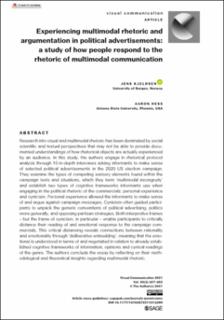| dc.contributor.author | Kjeldsen, Jens Elmelund | |
| dc.contributor.author | Hess, Aaron | |
| dc.date.accessioned | 2022-01-18T14:09:13Z | |
| dc.date.available | 2022-01-18T14:09:13Z | |
| dc.date.created | 2021-06-27T13:30:57Z | |
| dc.date.issued | 2021 | |
| dc.identifier.issn | 1470-3572 | |
| dc.identifier.uri | https://hdl.handle.net/11250/2838020 | |
| dc.description.abstract | Research into visual and multimodal rhetoric has been dominated by social scientific and textual perspectives that may not be able to provide documented understandings of how rhetorical objects are actually experienced by an audience. In this study, the authors engage in rhetorical protocol analysis through 10 in-depth interviews asking informants to make sense of selected political advertisements in the 2020 US election campaign. They examine the types of competing sensory elements found within the campaign texts and situations, which they term ‘multimodal incongruity’ and establish two types of cognitive frameworks informants use when engaging in the political rhetoric of the commercials: personal experience and cynicism. Personal experience allowed the informants to make sense of and argue against campaign messages. Cynicism often guided participants to unpack the generic conventions of political advertising, politics more generally, and opposing partisan strategies. Both interpretive frames – but the frame of cynicism, in particular – enable participants to critically distance their reading of and emotional response to the campaign commercials. This critical distancing reveals connections between rationality and emotionality through ‘deliberative embedding’, meaning that the emotional is understood in terms of and negotiated in relation to already established cognitive frameworks of information, opinions and cynical readings of the genre. The authors conclude the essay by reflecting on their methodological and theoretical insights regarding multimodal rhetoric | en_US |
| dc.language.iso | eng | en_US |
| dc.publisher | Sage | en_US |
| dc.rights | Navngivelse 4.0 Internasjonal | * |
| dc.rights.uri | http://creativecommons.org/licenses/by/4.0/deed.no | * |
| dc.title | Experiencing multimodal rhetoric and argumentation in political advertisements: a study of how people respond to the rhetoric of multimodal communication | en_US |
| dc.type | Journal article | en_US |
| dc.type | Peer reviewed | en_US |
| dc.description.version | publishedVersion | en_US |
| dc.rights.holder | Copyright 2021 The Author(s) | en_US |
| cristin.ispublished | true | |
| cristin.fulltext | original | |
| cristin.qualitycode | 1 | |
| dc.identifier.doi | 10.1177/14703572211013399 | |
| dc.identifier.cristin | 1918728 | |
| dc.source.journal | Visual Communication | en_US |
| dc.source.pagenumber | 327-352 | en_US |
| dc.identifier.citation | Visual Communication. 2021, 20 (3), 327-352. | en_US |
| dc.source.volume | 20 | en_US |
| dc.source.issue | 3 | en_US |

